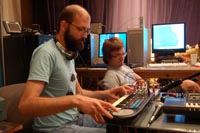
Extreme Freestyle Hacking
Hacking can refer to radical computer programming, but it's also a term with a wider reach. In political art it's called detournement ("the theft of aesthetic artifacts from their contexts and their diversion into contexts of one's own devise" (Greil Marcus)); in music and video it's mashup, remix, fantasia, or variations; in sound, circuit bending; in amateur radio and telephony, phreaking. Then there's gene hacking (Eduardo Kac's bunnies that glow in the dark) and culture hacking or bricolage (the refunctioning, by societal "outsiders", of symbols associated with the dominant culture, as in the appropriation of corporate attire and Vogue model poses by poor, gay, and largely nonwhite drag queens" (Mark Dery)). All of these are ways to describe modifying something to make it do things it wasn't meant to do.
For our purposes, a hacker is "an inventive
type, someone creative and unconventional, a person who sees doors
where others see walls or builds bridges that others thought
were planks on which to walk into shark-filled
seas. Hackers are alive with the spirit of Loki or Coyote or the
Trickster, moving with stealth across boundaries, often spurning
conventional ways of thinking and behaving. Hackers see deeply
into the arbitrariness of structures, how form and content are
assembled in subjective and often random ways and therefore how
they can be defeated or subverted. They see atoms where others see
a seeming solid, and they know that atoms are approximations of
energies, abstractions, mathematical constructions. At the top
level, they see the skull behind the grin, the unspoken or
unacknowledged but shared assumptions of a fallible
humanity." (From "Hacker Generations", by Richard
Thieme.)
planks on which to walk into shark-filled
seas. Hackers are alive with the spirit of Loki or Coyote or the
Trickster, moving with stealth across boundaries, often spurning
conventional ways of thinking and behaving. Hackers see deeply
into the arbitrariness of structures, how form and content are
assembled in subjective and often random ways and therefore how
they can be defeated or subverted. They see atoms where others see
a seeming solid, and they know that atoms are approximations of
energies, abstractions, mathematical constructions. At the top
level, they see the skull behind the grin, the unspoken or
unacknowledged but shared assumptions of a fallible
humanity." (From "Hacker Generations", by Richard
Thieme.)
Class is in studio and discussion format. This means that your active participation is a requirement of the course. During the semester we expect you to contribute your own ideas and arguments to the discussions, and to be willing to take the responsibilities and risks such contributions imply.
There are no written exams. Instead you will use the theories and tools you acquire during the semester to MAKE STUFF! about some aspect of postmodern gothic. What you make can be in any form: sound, installation, video, computer animation, collage, sculpture, assemblage, performance -- you name it. You will do this in stages, starting with simple projects and moving to more complex ones, using humor, irony, uncommon approaches, and bizarre techniques.
Download a pdf of the syllabus here
Requirements for ACTLab student web pages
Here's a resource we use for the course: Hackers, by Steven Levy
Glitching a Speak-n-Spell without circuit bending
A sinister chorus of tortured Furbies
The original course page, with more (and stranger) info, is here.








